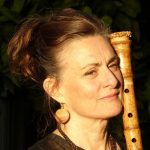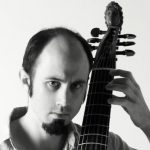
Ensemble Apotropaïk
Apotropaïque, (adj): Something that brings the evil away.
With its varied instrumentarium, the Apotropaïk ensemble aims to renew the approach to medieval repertoires with a young and lively perspective. It wishes to introduce these ancient repertoires, which are still largely unknown to the public, through speeches during performances, in order to make this music more accessible. This way, the listener is better able to remember and appreciate the moment of music he or she shares with the ensemble. Its repertoire extends from the end of the 12th century to the 15th century, from the first troubadour songs to the beginning of the Renaissance.

With its varied instrumentarium, the Apotropaïk ensemble aims to renew the approach to medieval repertoires with a young and lively perspective. It wishes to introduce these ancient repertoires, which are still largely unknown to the public, through speeches during performances, in order to make this music more accessible. This way, the listener is better able to remember and appreciate the moment of music he or she shares with the ensemble. Its repertoire extends from the end of the 12th century to the 15th century, from the first troubadour songs to the beginning of the Renaissance.
The ensemble met in 2015 at the Lyon Conservatory in the section of early music. All four have a weakness for medieval music and its rare instruments, such as the bow violin or the Gothic harp. For them, the range of colours offered by medieval instruments is surprisingly rich. The Ensemble Apotropaïk covers a very long period in the history of music: from the end of the 12th century to the end of the 15th century, at the beginning of the Renaissance. These three centuries of music are bursting with a variety of aesthetics.

When they play a concert, the aim is always the same: to touch the audience. On stage, they take the time to contextualize their works and present their instruments, which the visitors often see for the first time. Some of the compositions they play are as complex as contemporary scores. The educational work of artists like William Christie for 17th century scores has not yet been done for the Middle Ages, which suffer from the image of monotonous, boring music, according to Clémence Niclas in an interview. But there are great efforts to prove to the public that, on the contrary, this repertoire is rich and alive. Medieval music is underrepresented in concert halls. The programmers told them very clearly that they were sure to win the audience with Bach or Haydn, but not with Binchois or Dufay. It must be said that the power of the instruments is not the same and that a medieval music ensemble would not be able to play in a symphony hall. More intimate rooms would be needed for their music.
Its members performed together for the first time in November 2015 to share a concert with Korean traditionnal musicians at the Lyon CNSMD, organised within the frame of the « Année France-Corée 2015 » initiated by the Institut Français. The ensemble began its activity with an intercultural

dialogue. ApotropaïK had the chance to approach its practice and repertoire in the light of traditional Korean music. Members of ApotropaïK participated in a similar experience in September 2016: the ensemble was chosen to represent the Lyon CNSMD in the « Transcultural Confluence » project, which was the first stage of an international program gathering the Royal Academy of Music (Aarhus, Denmark) and the Conservatoire des Arts et Métiers Multimédia Balla Fasséké Kouyaté (Bamako, Mali). Participants had one week to imagine a performance with various aesthetics mixing pop, jazz, early music and non-European traditional music and also gathering on stage musicians and dancers. The ensemble worked from songs of Machaut and pieces from the London manuscript. This project week ended with a concert opened to a large audience at the Lyon CNSMD. It was a unique experience in terms of sharing. It raised the universal character of these repertoires, medieval secular monody being very representative in that sense, offering an infinite range of possible interpretations.

Since 2016, the ApotropaïK ensemble has been several times invited to play at the Cluny museum (National Museum of the Middle Ages) in Paris. It has also performed in prestigious festivals in France and Europe such as Mars en Baroque (Marseille) or the MAfestival (Bruges). In 2019 the ensemble will preform in the Gröpelinger Barock Festival (Bremen), the Festival de Sablé (Sablé-sur-Sarthe), the Heure Musicale du Jeudi (Nantes) and the Saison musicale des Chartreux (Lyon).
Its repertoire spreads from the 13th to the 15th century. It is focused on instrumental music such as Italian and French estampies from the London manuscript or the Chansonnier du Roi or diminutions from the Faenza Codex, and on vocal music such as troubadour’s songs, monodies from Machaut and Lescurel but also songs from Dufay for the Burgundian Court and Ars Subtilior melodies.
In November 2017 the ApotropaïK ensemble won the 1st prize of the second Vanves Early music festival competition.
















